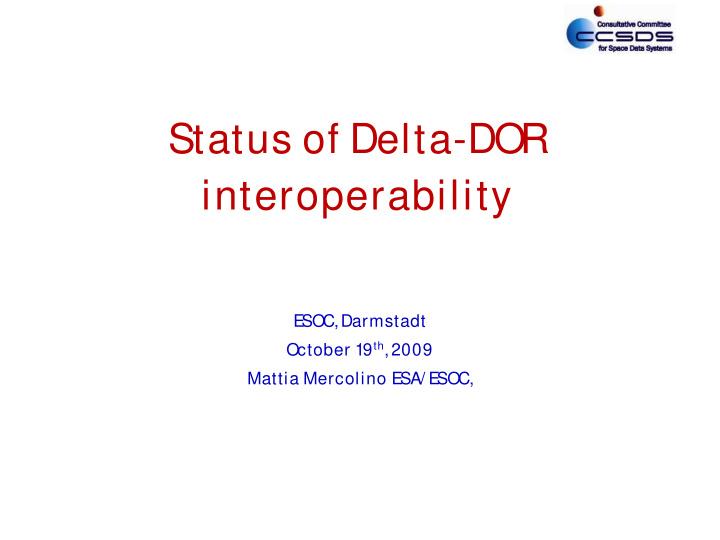



Status of Delta-DOR interoperability E SOC, Darmstadt October 19 th , 2009 Mattia Mercolino E SA/ E SOC,
Summary � ESA-JAXA Δ DOR tracking on Hayabusa / VEX � Status and plans of ESA enhanced Wideband Δ DOR for future supports to JPL � ESA-JPL wideband Δ DOR interoperability testing and MSL support
ESA-JAXA Δ DOR tracking on Hayabusa / VEX
Hayabusa observations � Acquisitions: � 2 acquisitions of Hayabusa were made during 2008 � During the first tracking there were problems in DSN antenna pointing for the uplink of ranging tones to the S/C, therefore only quasar and carrier signal were acquired � The second tracking was successful � Data translation: � After a first round of data translation / correlation, problems with biases of JAXA data when correlated against either NNO data or DSN data, were detected � Any need for further investigation? � How can ESA help on this?
VE X observations VEX is currently being observed monthly (once per month) by ESA in � order to provide JPL with plane-of-the-sky measurement of the S/C ESA provided JAXA with the dates for a VEX tracking in the 2009/2010 � timeframe This will most probably be the last opportunity to perform such mixed- � baseline validation on VEX Passes 2009 � DDOR Date in 2009 UTC 2010 DoY CEB 10 DEG BOA BOT EOT EOA 06-Nov 05:43-07:43 310 06:28 05:43 06:28 07:28 07:43 14-Dec 07:25-09:25 348 08:10 07:25 08:10 09:10 09:25 � Passes 2010 (confirmed at the moment) DDOR Date in 2010 UTC 2010 DoY CEB 10 DEG NNO BOA NNO BOT NNO EOT NNO EOA Status with NNO Comments 16-Feb 08:25-10:25 47 08:38 08:25 09:10 10:10 10:25 OK 20-Mar 08:05-10:05 79 08:00 08:05 08:50 09:50 10:05 OK 11-Apr 07:40-09:40 101 07:41 07:40 08:25 09:25 09:40 NOK Move to DSN 10-May 07:50-09:50 130 07:43 07:50 08:35 09:35 09:50 NOK Move to DSN 23-Jun 08:50-10:50 174 08:52 08:50 09:35 10:35 10:50 NOK Move to DSN JAXA to identify suitable dates for the support � ESA / JAXA to plan and execute the observation(s) �
enhanced Wideband Δ DOR Status and plans of ESA
SA enhanced wideband Δ DOR (1) E � From Phoenix support experience, the limiting factor of ESA Δ DOR accuracy is the total spanned bandwidth at the receiver (maximum 28 MHz) that allows the reception of only one of the Δ DOR tones at X-band (19 MHz wrt the carrier) � ESA is undergoing an activity to upgrade its Δ DOR receiving capabilities for wideband Δ DOR (i.e. use of both 19 MHz tones and/or 2 nd harmonics of such tones) � Some rewiring of the back-end at both Cebreros and New Norcia DSA was performed during summer 2009.
SA enhanced wideband Δ DOR (2) E � In order to be able to acquire the spectrum � The wiring will be upgraded as follows
SA enhanced wideband Δ DOR (3) E � The new wiring was installed in Cebreros and New Norcia later than expected due to the slip pf Herschel-Plank launch. � At both stations the wiring concept was successfully validated during Summer 2009 � Dry-run tests were run in late September showing that some modification is needed in the IFMS receiver. Such modification has already been requested and work is currently on-going. � Modifications on the S/W correlator are also needed. These will be undertaken during 2010. � The objective is to acquire data in Wide-band during the first months of 2010 for later processing.
ESA-JPL wideband Δ DOR interoperability testing and support to MSL
MRO observations � In order to fully validate the ESA wideband Delta-DOR functionality the following options are foreseen: � First functional validation of the acquisition with one station only � First end-to-end validation on ESA S/C (VEX in the frame of th eactivity already foreseen) � Real-scenario validation using a S/C with DOR tones at X-band � candidate MRO. Is this feasible in the frame of the mutual agreement between JPL and ESA for Delta-DOR operations? Any other S/C that could be used? � Two are the configuration to be tested: � Delta-DOR from ESA stations only � Delta-DOR in mixed-baseline mode Since data translation from/to VSR has already been proven, the � observations on MRO would: � Validate ESA wideband raw data capture � Validate ESA capability of correctly correlate data acquired in wideband at its stations � Validate ESA capability of correctly correlate data acquired in wideband in mixed-baseline mode
Tentative schedule � ESA-JPL MRO Delta-DOR tentative schedule: Apr. 2009 Dec. 09 Sept. 10 TBD 10 HW upgrades readiness SW upgrades readiness Tracking and data processing and validation � JPL to provide ESA with possible tracking dates � ESA to arrange such trackings within its station schedule
Δ DOR support to MSL? � ESA is undertaking an upgrade to wideband Delta-DOR in order to be able to support recordings up to 100 MHz wide (the limitation in this case is the diplexer) in the band 8.4 – 8.5 GHz � This should enhance the Delta-DOR accuracy of the ESA system to the same level of the JPL system � Once the capability is installed, verified and tested in a real-case scenario (i.e. with VEX and then with MRO), JPL and ESA could jointly produce and distribute to the MSL project a Memo outlining the obtained results � Status of MSL project? � Request for ESA DDOR support?
Recommend
More recommend